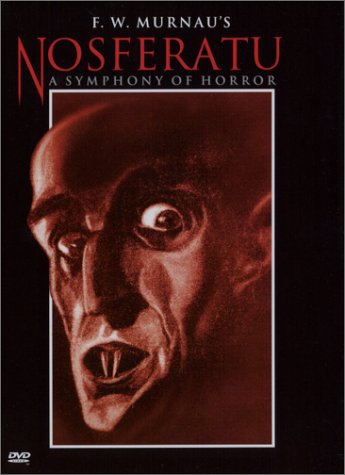
NOSFERATU
Germany, 1922, 94 minutes, Black and white.
Max Schreck, Alexander Granach.
Directed by F.W. Murnau.
Nosferatu is the first major film presenting Dracula. It was based on Bram Stoker's novel, although there were legal complications at the time. Soon after there was the American version with Bela Lugosi, Todd Browning's Dracula. Dracula has been popular ever since, with spoofs and variations in the '40s and '50s. Hammer Studios introduced Christopher Lee in the late '50s and there was a series starring him. Amongst many other variations there were also satires e.g. Billy the Kid Vs. Dracula in 1965. Vampires and Dracula revived in the '70s with many elaborate productions e.g. Werner Herzog's Nosferatu which was a homage to Murneau's film and followed it closely in tone and screenplay, John Badham's version of Stoker's novel with Frank Langella and Laurence Olivier.
Francis Ford Coppola made a masterpiece version, 1992, Bram Stoker's Dracula, with Gary Oldman and a top cast.
Satires included Vampira with David Niven and Love At First Bite with George Hamilton. There was a black vampire Blacula. This says a lot about the perennial appeal of the myths of the living dead and incarnate evil with the overtones of sexuality. It is interesting to go back to this original version to see the basic screenplay, the lack of dialogue, the miming of the themes. The special effects are quite outstanding for the their time and suggest an eerie atmosphere. The Dracula character is quite sinister in his appearance, not the tall, dark and handsome vampire. The film was a success in its time and is important for the historical study of the German cinema of the '20s.
In 2000, Shadow of the Vampire told the story of the making of this film with the premiss that Max Schreck, played by Willem Dafoe, really was a vampire. John Malkovich portrayed Murneau.
1. The popularity of Bram Stoker's novel? By the early '20s? Its later history and the series of films made? The originality of this version? Its later imitations? The use of the basic plot from the novel? The appeal in the '20s? The example within the context of German surrealism and the styles of the '20s?
2. The characteristics of German filmmaking at the time? The atmosphere of the '20s, silent films, styles of acting, captions? Angle shots, light and shadow etc.?
3. The quality of the black and white photography? The realism and contrived style of the sets? The acting and the characters representing types? The creation of a mood? The suggestions of horror and enveloping the audience in an atmosphere of horror? The ugliness of the world of the undead? Fright, shock, mystery?
4. The symbol of the town of Bremen and the plague? Research for the plague? The mystery of the ship, the presentation of the city? The ending? Evil coming from the outside and corrupting, a visitation of malevolence? The relevance of this kind of parable for Germany in the '20s and '30s?
5. The folklore and traditions about vampires? As presented in Bram Stoker's book, in history, in local superstition, fear? Vampires as phantoms? The nature of the undead? The need for blood? The attraction towards the beautiful and young? Lust and evil? The corruption of love? How well were these themes incorporated into the film?
6. The presentation of the Harkers, Jonathan and his age, his having to travel to Transylvania, the details of his journey and the implications? His becoming pale, fearful? The horses? The arrival at the castle and the confrontation with Nosferatu? The meal, the injury, the blood? The importance of the dreams and the relationship to Nina? His being bitten by the vampire? The importance of his escape, the letter and his return? The hero with the truth? The contrast with Nina and her presence in his dreams, the reality? Nina and the somnambulistic style? The doctor and his puzzle? Nina on the sand dunes? Jonathan's return, the confrontation with Dracula, Nina giving of herself as a saviour? Her death?
7. The characterisation of Renfield - sinister character, madness, the asylum?
8. The neighbours and their contribution, care for Nina? The doctors? Van Helsing and his reputation, his research, his confrontation with Dracula?
9. The atmosphere of the ship, the raft, the plague, deaths, the sailors, the log and the vampire killing his victims?
10. The total focus on Nosferatu? the elaborate nature of his plan, his wanting to move from Transylvania, the evil visitor, the castle and its appearance his presence there, his way of life, walking by night, buried by day, Nosferatu and his memories, the greeting of Harker, the suggestions of his thirst for blood, his haunting people, the plan of his being buried, transported, his power, his lust as being the means of his downfall and death?
11. The quality of the film as a silent horror classic with so few precedents? Establishing patterns for subsequent horror films?